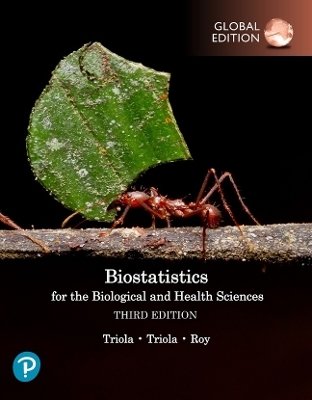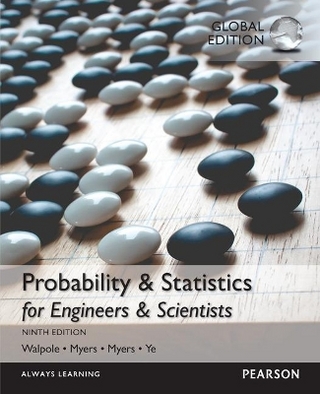
A First Course in Statistical Methods (with CD-ROM)
Brooks/Cole
978-0-534-40806-0 (ISBN)
- Titel ist leider vergriffen;
keine Neuauflage - Artikel merken
A FIRST COURSE IN STATISTICAL METHODS addresses a pressing need in the methods course-a shorter text designed for a one-term course. By selecting and revising material from their best-selling two-semester text, AN INTRODUCTION TO STATISTICAL METHODS AND DATA ANALYSIS, Fifth Edition, the authors created an ideal book for a one-term course in statistical methods. Based on the belief that statistics is a thought process tied to the scientific method, the text utilizes a 5-step approach: 1) defining the problem, 2) collecting data, 3) summarizing data, 4) analyzing and interpreting the data, and 5) communicating the results of the analysis.
Michael Longnecker currently serves as Professor and Associate Department Head at Texas A&M University. He received his B.S. at Michigan Technological University, his first M.S. at Western Michigan University, his second M.S. at Florida State University, and his Ph.D. at Florida State University. He is interested in Nonparametrics, Statistical Process Control, and Statistical Consulting.
Step 1: DEFINING THE PROBLEM. 1. Statistics and the Scientific Method. Introduction. Why Study Statistics? Some Current Applications of Statistics. A Note to the Student. Staying Focused. Step 2: COLLECTING DATA. 2. Collecting Data Using Surveys and Scientific Studies. Introduction. Surveys. Sampling Designs for Surveys. Scientific Studies. Experimental Designs for Scientific Studies. Observational Studies. Data Management: Preparing Data for Summarization and Analysis (Optional). Staying Focused. Step 3: SUMMARIZING DATA. 3. Summarizing Data. Introduction. Calculators, Computers, and Software Systems. Summarizing Data on a Single Variable: Graphical Methods. Summarizing Data on a Single Variable: Measures of Central Tendency. Summarizing Data on a Single Variable: Measures of Variability. The Boxplot. Summarizing Data from More than One Variable. Encounters with Real Data. Staying Focused. 4. Probability and Probability Distributions. How Probability Can Be Used in Making Inferences. Finding the Probability of an Event. Basic Event Relations and Probability Laws. Conditional Probability and Independence. Bayes Formula. Variables: Discrete and Continuous. Probability Distributions for Discrete Random Variables. A Useful Discrete Random Variable: The Binomial. Probability Distributions for Continuous Random Variables. A Useful Continuous Random Variable: The Normal Distribution. Random Sampling. Sampling Distributions. Normal Approximation to the Binomial. MINITAB Instructions (Optional). Staying Focused. Step 4: ANALYZING DATA, INTERPRETING THE ANALYSES, AND COMMUNICATING THE RESULTS. 5. Inferences About Population Central Values. Introduction. Estimation of ?. Choosing the Sample Size for Estimating ?. A Statistical Test for ?. Choosing the Sample Size for Testing ?. The Level of Significance of a Statistical Test. Inferences about ? for Normal Population, o Unknown. Inferences about Median. Encounters with Real Data. Staying Focused. 6. Inferences Comparing Two Population Central Values. Introduction. Inferences about ?1-?2: Independent Samples. A Nonparametric Alternative: The Wilcoxon Rank Sum Test. Inferences about ?1-?2: Paired Data. A Nonparametric Alternative: The Wilcoxon Signed-Rank Test. Choosing Sample Sizes for Inferences about ?1-?2. Encounters with Real Data. Staying Focused. 7. Inferences About Population Variances. Introduction. Estimation and Tests for a Population Variance. Estimation and Tests for Comparing Two Population Variances. Tests for Comparing t > 2 Population Variances. Encounters with Real Data. Staying Focused. 8. The Completely Randomized Design. Introduction. The Model for Observations in a Completely Randomized Design. Analyzing Data from a Completely Randomized Design: An Analysis of Variances. Checking on the AOV Conditions. A Nonparametric Alternative: The Kruskal-Wallis Test. Multiple Comparisons. Encounters with Real Data. Staying Focused. 9. More Complicated Experimental Designs. Introduction. Randomized Complete Block Design. Latin Square Design. Factorial Treatment Structure in a Completely Randomized Design. Factorial Treatment Structure in a Randomized Complete Block Design.Estimation of Treatment Differences and Comparisons of Treatment Means. Encounters with Real Data. Staying Focused. 10. Categorical Data. Introduction. Inferences About a Population Proportion ?.Inferences About the Difference Between Two Population Proportions ?1- ?2. Inferences About Several Proportions: Chi-Square Goodness-of-Fit Test. Contingency Tables: Tests for Independence and Homogeneity. Odds and Odds Ratios. Encounters with Real Data. Staying Focused. 11. Linear Regression and Correlation. Introduction. Estimating Model Parameters. Inferences about Regression Parameters. Predicting New y Values Using Regression. Examining Lack of Fit in Linear Regression. The Inverse Regression Problem (Calibration). Correlation. Encounters with Real Data. Staying Focused. 12. Multiple Regression. Introduction. Estimating Multiple Regression Coefficients. Inferences in Multiple Regression. Testing a Subset of Regression Coefficients. Comparing the Slopes of Several Regression Lines. Logistic Regression. Encounters with Real Data. Staying Focused. 13. Communicating and Documenting the Results of Analyses. Introduction. The Difficulty of Good Communication. Communication Hurdles: Graphical Distortions. Communication Hurdles: Biased Samples. Communication Hurdles: Sample Size. Preparing Data for Statistical Analysis. Guideline for a Statistical Analysis and Report. Documentation and Storage of Results. Staying Focused. Appendix. References. Selected Answers. Index.
| Verlagsort | CA |
|---|---|
| Sprache | englisch |
| Themenwelt | Mathematik / Informatik ► Mathematik ► Statistik |
| Wirtschaft ► Volkswirtschaftslehre ► Ökonometrie | |
| ISBN-10 | 0-534-40806-0 / 0534408060 |
| ISBN-13 | 978-0-534-40806-0 / 9780534408060 |
| Zustand | Neuware |
| Haben Sie eine Frage zum Produkt? |
aus dem Bereich

